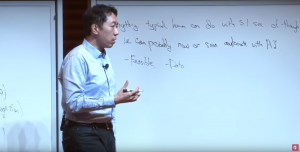6 AI in Business and Social Sciences
Megan Mocko & Alexandra Bitton-Bailey, Ph.D.
Business
- Businesses can use AI to help inform business practices such as what items should be put on sale, what items a customer might be interested in, or when to reach out to customers if an AI system determines that the customer might continue service.
- A podcast from EMERJ, the AI research and advisory company, Levi Strauss’s Chief AI Officer Katia Walsh describes important concepts of AI in retail. (27 mins. 13 sec.)
- Finance: AI is poised to have significant impacts in the financial industry. AI can help reform the financial sector first by providing instant personalized supports to customers. In addition, Ai is able to improve banking and financial institutions’ ability to assess risks reliably. AI and Machine Learning are transforming individuals’ ability to better financially plan for themselves through apps that are able to analyze financial information and thus make better financial planning decisions.
Journalism and Communications
- AI was the engine that proliferate much fake news to people, however, companies such as Google and Microsoft have issued the Fake News Challenge to try and remedy the issue by using machine learning and natural language processing to determine the truth behind articles automatically.
Production Industry

- Industry uses artificial intelligence to determine if there are defects in produced parts as well as in automation.
- The University of Helsinki has created an online free course called “Elements of AI”. The first day describes three applications of the use of AI: driverless cars, image and video processing, and content recommendation.
- Andrew Ng’s talk entitled Artificial Intelligence is the New Electricity. He talks about four main topics: major trends in AI, impacts of AI on the industry, the process of working with AI, and the societal impact of AI. Presented Feb. 2nd, 2017. The presentation is about 1 hour long with an additional 27 minutes for questions.
Reducing Inequalities and Poverty
- The University of Chicago, project Aequitas in partnership with IBM’s AI Fairness 360 are helping to track and correct bias. Another positive example of AI’s Impact on reducing inequalities is The Imperial College of London’s Work to train AI to recognize poverty and living conditions through street images in the hopes to make positive changes to situations.
- AI tools such as the Nutrition Early Warning System (NEWS) use machine learning and big data. These tools are being used to identify regions that are at increased risk of food shortages due to crop failure, rising food prices, and drought.
Security
- AI has far-reaching impacts in the field of security. AI can help keep homes safe through security cameras that are able to distinguish between family members and strangers before triggering an alarm. Using image and face recognition can help alert organizations to exist security risks.
Transportation AI
- AI in this field is able to analyze video traffic and help make informed decisions. We can use AI to decide which routes to take or how to adjust traffic light signals to account for traffic patterns.
Additional Tools
Educational Tools
- Daniel Smilkov and Shan Carter created, TensorFlow, a website that allows user to try their own hand at building a neural network without coding or mathematics.
- Google provides interactive websites that illustrate some of the power of AI. Quick, Draw! has the participant draw an image while the program guesses what is drawn. Teachable machine has students build an AI to read images and audio without the need to learn to code.
- Google Experiments includes a way to understand neural networks through their Google Experiment: What Neural Networks See
Tools for People with Disabilities
- StorySign uses AI and augmented reality to help deaf children learn to read by translating texts into sign language. Facing emotions is another app that can translate emotions into simple sounds to help blind persons “see” who they are talking with.

Feedback/Errata